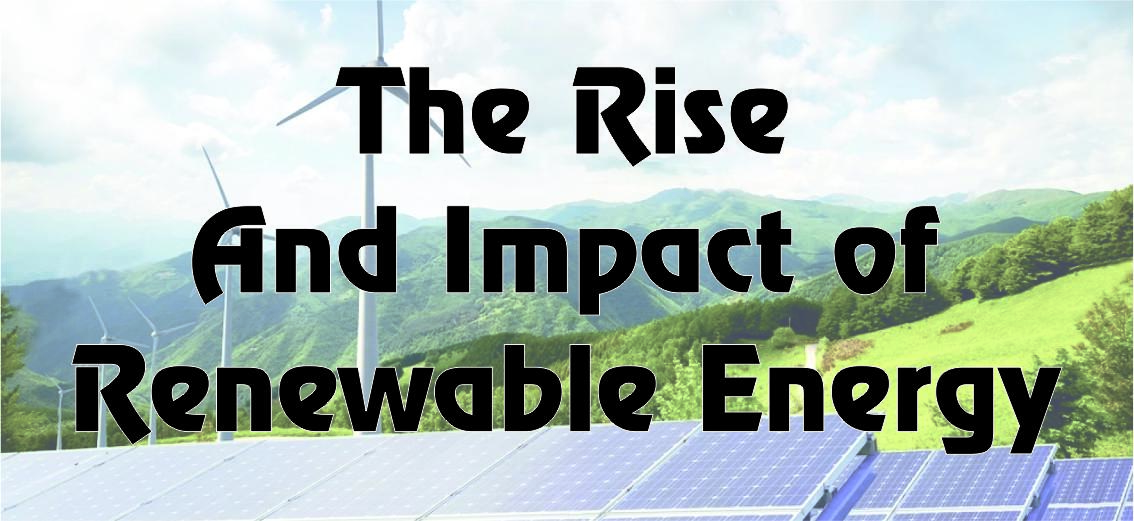The Rise and Impact of Renewable Energy
Blogs Home
- 15 Jul 2024

Renewable energy has become a cornerstone of modern energy policy, driven by the need to mitigate climate change, reduce dependency on fossil fuels, and ensure sustainable development. As global energy demand continues to rise, the transition to renewable energy sources has become critical to achieving environmental and economic sustainability.
This blog aims to explore the rise and impact of renewable energy, with a particular focus on the context of India. We will delve into the historical evolution, types of renewable energy sources, economic and environmental impacts, policy landscape, technological innovations, case studies, social impacts, and future trends.
Historical Background and Evolution
Renewable energy and its history can be taken back to 4000 years ago. Various civilizations have been known to harness the power of sun , wind and water for various purposes. Waterwheels were used in China and Europe which dates back to 2nd Century AD. The water wheels were used for power mills, pumps, forge bellow , irrigation etc.
Windmills were utilized for mechanical purposes which ran on wind power. Netherlands had popularized it during the 1590s AD. When it comes to solar collectors, the first of its kind was invented during 1767.
Types of Renewable Energy Sources
Solar Energy: Innovations and Applications
India is the third largest generator of solar energy as of 2023. The increase in solar generation increased by 18 terawatt hour or TWH. Innovations such as floating solar panels and bifacial solar modules are enhancing efficiency and application.
Wind Energy: Technological Developments and Efficiency
India ranks fourth globally in wind energy capacity, with over 38 GW installed. Technological advancements in turbine design and offshore wind projects are driving further growth.
Hydropower: Current Trends and Environmental Considerations
Hydropower contributes around 12% of India's total renewable capacity. Small hydropower projects are gaining traction due to their lower environmental impact compared to large dams.
Biomass Energy: Utilization and Challenges
Biomass energy, derived from organic materials, is a significant source in rural India. The challenge lies in balancing biomass use for energy with agricultural and environmental sustainability.
Geothermal Energy: Exploration and Utilization Techniques
Geothermal energy is still in nascent stages in India, with potential sites in the Himalayan region. Pilot projects are exploring its feasibility for wider application.
Economic Impacts of Renewable Energy
Job Creation and Industry Growth: Renewable energy sectors are major job creators. In 2022, the renewable energy sector in India employed eight times more hiring than 2020-21. Around 53000 workers were employed in project development roles in 2021-22.
Cost Competitiveness and Market Dynamics: The cost of renewable energy has drastically decreased. Solar PV module costs have fallen by 85% over the past decade.
Investment Opportunities and Financial Incentives: India's renewable energy sector has attracted significant investment, with over $10 billion invested in 2022 alone. Government incentives such as tax benefits and subsidies continue to support this growth.
Environmental Benefits and Challenges
Reduction of Greenhouse Gas Emissions
Renewable energy significantly reduces greenhouse gas emissions. India's renewable energy projects have prevented millions of tons of CO2 emissions annually, contributing to global climate goals.
Conservation of Natural Resources
Renewables help conserve natural resources by reducing the need for coal, oil, and gas. This conservation is crucial for maintaining ecological balance and preventing resource depletion.
Addressing Intermittency and Energy Storage Solutions
Intermittency remains a challenge for renewables like solar and wind. Advances in energy storage solutions, such as lithium-ion batteries and pumped hydro storage, are crucial for ensuring a reliable energy supply.
Government Initiatives and Subsidies
National Action Plan on Climate Change (NAPCC): The Government of India has launched several initiatives to promote renewable energy, with the NAPCC being a cornerstone policy. The NAPCC, launched in 2008, includes eight national missions, two of which are directly focused on renewable energy: the National Solar Mission and the National Mission for Enhanced Energy Efficiency.
State-Specific Solar Policies: Several Indian states have implemented their own solar policies to supplement national efforts. States like Gujarat, Rajasthan, and Tamil Nadu have been pioneers, offering incentives such as tax exemptions, subsidies, and simplified land acquisition processes to attract investments in solar energy.
Subsidies for Solar Rooftops and Wind Energy Projects: The government provides capital subsidies for solar rooftop installations, making it more affordable for residential, commercial, and industrial users. The Ministry of New and Renewable Energy (MNRE) offers a subsidy of up to 40% for residential solar rooftops. Additionally, wind energy projects benefit from accelerated depreciation benefits, which allow project developers to deduct a significant portion of the project's cost from their taxable income.
Green Energy Corridor: The Green Energy Corridor project aims to facilitate the integration of renewable energy into the national grid. This involves strengthening the transmission network and ensuring grid stability. The project has received funding from both the Indian government and international agencies like the World Bank and the Asian Development Bank.
International Agreements and Collaboration
International Solar Alliance (ISA)
- India co-founded the International Solar Alliance in 2015, along with France, to promote solar energy globally. The ISA aims to facilitate cooperation among its member countries to enhance solar energy deployment, reduce the cost of solar power, and develop innovative financing mechanisms. As of 2024, the ISA has 119 signatory countries.
Collaborations with Other Countries
- India has entered into several bilateral agreements to promote renewable energy. For example, India and Germany have partnered on various projects to enhance energy efficiency and renewable energy adoption. Similarly, India and the US have launched the US-India Clean Energy Finance Task Force to facilitate investment in clean energy projects.
Indian Context of Renewable Energy
As per statistics on renewable energy in 2024, India has a combined installed energy capacity of 195.01 GW. Here is the distribution percentage:
- Wind power: 46.65 GW
- Solar Power: 85.47 GW
- Biomass/Co-generation: 10.35 GW
- Small Hydro Power: 5 GW
- Waste To Energy: 0.59 GW
- Large Hydro: 46.92 GW
Among the states, Rajasthan has the highest estimated potential of renewable power with 20.3%. Rajasthan is followed by Maharashtra and Gujarat who have 11.79% and 10.45% respectively.
Policy Challenges and Future Directions
Grid Integration: Integrating a high share of renewable energy into the grid poses technical challenges, including maintaining grid stability and managing intermittency. The government is working on advanced grid management techniques, including the deployment of smart grids and energy storage solutions.
Land Acquisition: Securing land for large-scale renewable energy projects, particularly solar farms and wind parks, remains a significant challenge. The government is exploring ways to streamline land acquisition processes and promote the use of wastelands and degraded lands for renewable energy projects.
Financing: Despite significant investments, financing remains a hurdle, especially for smaller developers. The government is working to enhance access to low-cost financing through measures such as green bonds and credit guarantee schemes. In 2022, India's issuance of green bonds reached $8 billion, reflecting growing investor interest in sustainable projects.
Future Directions:
- Enhanced Policy Frameworks: Future policy directions include enhancing frameworks to support emerging technologies such as offshore wind and advanced biofuels.
- Innovation and Research: Increased funding for research and development in renewable technologies is crucial. The government is encouraging public-private partnerships to drive innovation.
- Decentralized Renewable Energy: Promoting decentralized renewable energy solutions, such as solar rooftops and mini-grids, to ensure energy access in remote and rural areas.
- Energy Storage Solutions: Developing and deploying large-scale energy storage solutions to address the intermittency of renewable energy sources. This includes projects like the proposed 1 GW grid-connected battery storage system in Ladakh.
Social and Community Impacts
Energy Access in Developing Regions
Renewable energy projects are crucial for providing energy access in remote and rural areas. In India, solar micro-grids and biogas plants have transformed energy availability in underserved communities. For example, the Darbari Village in Uttar Pradesh experienced a significant improvement in quality of life after the implementation of solar micro-grids, which provided reliable electricity for the first time. This allowed local businesses to operate more efficiently and children to study after dark, improving educational outcomes.
Community-Led Renewable Projects
Community involvement in renewable projects enhances sustainability and local buy-in. Examples include cooperative wind farms and community solar initiatives in India. The Dharnai Solar Initiative in Bihar, led by Greenpeace India, is a prominent example where the entire village was powered by a 100-kW solar micro-grid. This project not only provided consistent energy but also fostered a sense of ownership among the villagers, leading to better maintenance and sustainability of the system.
Public Perception and Awareness Campaigns
Public awareness campaigns, such as India's 'Green Energy Corridor' initiative, play a vital role in promoting the benefits of renewable energy and encouraging adoption. The Green Energy Corridor project, initiated by the Indian government, aims to integrate renewable energy into the national grid efficiently. Extensive awareness campaigns and community engagement programs under this initiative have educated the public about the importance of renewable energy, leading to increased support and faster implementation of green projects across the country.
Conclusion
This blog has explored the rise and impact of renewable energy, highlighting its historical evolution, economic and environmental benefits, policy landscape, technological innovations, successful case studies, and social impacts.
The imperative for continued innovation and investment in renewable energy cannot be overstated. As India and the world move towards a more sustainable future, renewable energy will play a pivotal role in ensuring a cleaner, greener, and more prosperous planet for future generations.
Sources:
- https://www.statista.com/statistics/710021/estimated-potential-share-of-renewable-power-by-region-india/
- https://www.ibm.com/blog/renewable-energy-history/
- https://economictimes.indiatimes.com/industry/renewables/india-overtook-japan-to-become-worlds-3rd-largest-solar-power-generator-in-2023/articleshow/109954448.cms?from=mdr
- https://economictimes.indiatimes.com/industry/renewables/india-overtook-japan-to-become-worlds-3rd-largest-solar-power-generator-in-2023/articleshow/109954448.cms?from=mdr
- https://powermin.gov.in/en/content/green-energy-corridor
- https://www.nitiforstates.gov.in/best-practice-detail?id=103886





